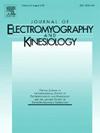Measurement of voluntary activation of abdominal flexors using transcranial magnetic stimulation
IF 2.3
4区 医学
Q3 NEUROSCIENCES
引用次数: 0
Abstract
Background
Transcranial magnetic stimulation (TMS) has been used to assess voluntary activation (VA) of limb and back muscles, however its ability to assess abdominal muscle VA is unknown. The assessment of abdominal muscle VA using TMS could be applied to patients with trunk dysfunction to enable further understanding of the neurophysiology of trunk control, inform practice and enable the development and monitoring of rehabilitation programmes.
Aim
The aim of this study was to investigate use of TMS and the twitch interpolation technique to measure voluntary activation of abdominal muscles.
Methods
Twenty healthy participants performed sets of isometric abdominal contractions of varying levels, during which TMS was applied to the primary motor cortex. The evoked twitches were measured as torque, while simultaneous surface electromyographic (EMG) activity was recorded bilaterally from rectus abdominis, erector spinae, tensor fasciae latae, and rectus femoris. VA was calculated as: (1 – superimposed twitch amplitude/estimated resting twitch amplitude) x 100. Estimated resting twitch amplitude was calculated by extrapolation using linear regression of superimposed twitch amplitude against torque for contraction strengths 50–100 % maximum voluntary contraction (MVC).
Results
There was a strong linear relationship between voluntary torque of 50–100 % MVC and TMS-evoked twitch amplitude (r2 = 0.994, p = 0.035), and voluntary torque between 50–100 % MVC and VA (r2 = 0.997, p = 0.025). VA at a target torque of 100 % MVC was less than 100 % (86.20 ± 2.29 %).
Conclusions
VA of abdominal muscles can be assessed with twitch interpolation using TMS. VA has been shown to be submaximal during maximum voluntary contractions, and it has been demonstrated that superimposed twitch amplitude decreases in a linear fashion with increasing contraction intensity. Using this technique to explore trunk muscle function could help to improve understanding of the neurophysiology of trunk control, including the sites on any deficit in drive and also improve monitoring of the efficacy of treatment regimes for clinical conditions associated with dysfunctions in trunk control e.g. low back pain.
经颅磁刺激测量腹屈肌的主动激活。
背景:经颅磁刺激(TMS)已被用于评估肢体和背部肌肉的自愿激活(VA),但其评估腹肌VA的能力尚不清楚。使用TMS评估腹肌VA可应用于躯干功能障碍患者,从而进一步了解躯干控制的神经生理学,为实践提供信息,并使康复方案的制定和监测成为可能。目的:本研究的目的是探讨使用经颅磁刺激和抽搐插值技术来测量腹部肌肉的随意激活。方法:20名健康参与者进行了不同程度的腹部收缩,在此期间,TMS应用于初级运动皮层。诱发抽搐以扭矩测量,同时记录双侧腹直肌、竖脊肌、阔筋膜张肌和股直肌的肌表面电图活动。VA计算为:(1 -叠加抽搐振幅/估计静息抽搐振幅)× 100。估计静息抽搐振幅通过外推法计算,使用叠加抽搐振幅与收缩强度50- 100%最大自愿收缩(MVC)扭矩的线性回归。结果:50- 100% MVC的自主转矩与tms诱发的抽搐幅度呈较强的线性关系(r2 = 0.994, p = 0.035), 50- 100% MVC与VA的自主转矩呈较强的线性关系(r2 = 0.997, p = 0.025)。在目标扭矩为100% MVC时,VA小于100%(86.20±2.29%)。结论:经颅磁刺激可应用抽搐插值法评估腹肌VA。在最大自主收缩期间,VA已被证明是次极大的,并且已被证明,随着收缩强度的增加,叠加抽搐幅度呈线性递减。使用这项技术来探索躯干肌肉功能可以帮助我们更好地理解躯干控制的神经生理学,包括驱动缺陷的部位,也可以改善对与躯干控制功能障碍(如腰痛)相关的临床疾病治疗方案疗效的监测。
本文章由计算机程序翻译,如有差异,请以英文原文为准。
求助全文
约1分钟内获得全文
求助全文
来源期刊
CiteScore
4.70
自引率
8.00%
发文量
70
审稿时长
74 days
期刊介绍:
Journal of Electromyography & Kinesiology is the primary source for outstanding original articles on the study of human movement from muscle contraction via its motor units and sensory system to integrated motion through mechanical and electrical detection techniques.
As the official publication of the International Society of Electrophysiology and Kinesiology, the journal is dedicated to publishing the best work in all areas of electromyography and kinesiology, including: control of movement, muscle fatigue, muscle and nerve properties, joint biomechanics and electrical stimulation. Applications in rehabilitation, sports & exercise, motion analysis, ergonomics, alternative & complimentary medicine, measures of human performance and technical articles on electromyographic signal processing are welcome.

 求助内容:
求助内容: 应助结果提醒方式:
应助结果提醒方式:


